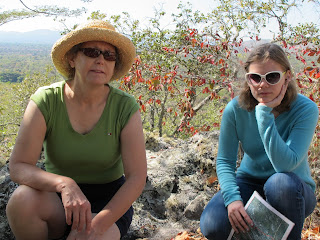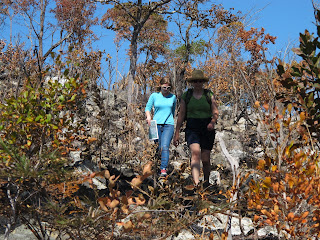Monday morning we toured the
Shiwa Ng'andu manor house, then drove through their private game preserve. The book "The Africa House" by Christina Lamb has a good historical background for more information. The house fell into disrepair, but Charlie Harvey (Mark's brother) has been restoring it, and that is not a simple task out this far from everything.
This is at the "clock" tower, and serves as the entry into the estate. These signs are quite old, and where we thought there would be a person to screen entry, there were simply deserted rooms.
Beyond the clock tower was a lane leading up to the house. It was lined with enormous eucalyptus trees and agave plants. Lady Gore-Browne had them planted to produce essential oils.
Looking back toward the clock tower, from the estate side.
This archway and stairs help form what must have, at one time, been an impressive avenue leading to the manor house.
The metal sculptures, both here (lion and rhino) and grazing animals at the Hot Springs, were quite impressive.
Looking at the manor house. All the bricks were formed and fired using local materials. I believe Tom told me at the end they had created well over 12,000,000 bricks!
Sir Stewart Gore-Browne was retired from the British Army, having been posted in colonial India, and also fighting in the First World War. He was nicknamed black rhinoceros by the local Bemba, according to our guide, because of his short, rotund stature and quick, razor sharp temper.
This marks the beginning of the building in 1928. The L is for his wife Lorna, and S for Stewart.
And when the manor was completed, 1932. Building on the estate continued well into the 1940s.
Sir Gore-Browne traveled extensively, and from one such trip brought back this hand carved Chinese chest. It is kept in a darkened place, and the beautiful detail was not revealed until Tom took this photo.
Some of the many more leather travel cases used by the family in their travels.
Looking out from the front balcony area from the library. The dog in the foreground is a Rhodesian Ridgeback, such huge and friendly animals.
The library is filled to capacity with classics. Included here is a trophy bestowed on one of Sir Stewart's uncle, who was president of New Zealand that was presented in thanks from New Zealand at his retirement. If I have conveyed any inaccuracies, just realize this is based on what our guide informed us about. Having been mislead on many of our other visits to other historic places we have learned to take most of what is relayed by docents with a huge grain of salt. Though, this was genuinely from New Zealand.
One of many, many fireplaces used to keep the home warm during the dry season.
Another set of treasures, ancient artifacts collected from Africa and China. Some dated back to well over 1000 years old.
The manor house also offers 4 suites that can be rented out. This was one of the larger ones, with it's own bathroom. The bathroom was huge, including a "couch", I suppose so the person taking a bath wouldn't be lonely. The furniture was all original, and most of the pieces were actually built in the house in each room, and will never be able to be removed unless destroyed. The joke about a man building a boat in the basement flashed through my mind when the guide relating this fact.
The downstairs parlor, directly below the library.
Outside, this is the rhino sculpture.
And not to be left out, this mama goat made certain we took her picture, then shooed us off the lawn.
I think she was more the guard animal than the dogs.
Looking back down the archway. You can imagine how lush this is during the wetter time of the year, and how impressive it was before the inevitable African decay begins to retake and reclaim ground.
Next stop that morning was the boat house, lake and drive through their private game reserve.



































































